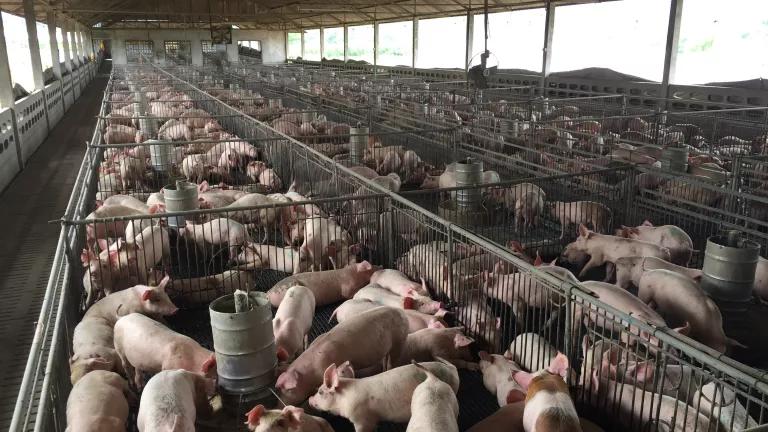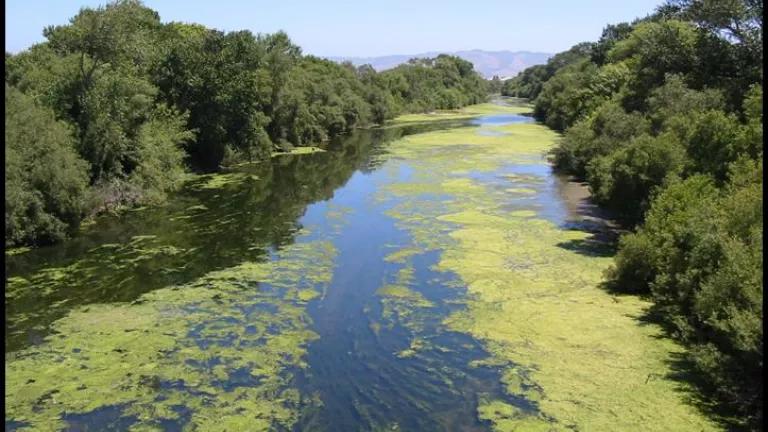Big Ag Is Hiding in Plain Sight and It’s Making Us Sick
More than 9 billion animals are raised for food each year in the United States, the vast majority on Concentrated Animal Feeding Operations (CAFOs). These massive industrial facilities not only confine animals in horrific conditions, but they are major polluters of the air and water.

Hog CAFO
More than 9 billion animals are raised for food each year in the United States, the vast majority on Concentrated Animal Feeding Operations (CAFOs). These massive industrial facilities not only confine animals in horrific conditions, but they are major polluters of the air and water. Animals make waste, and the waste from CAFOs causes air pollution that hurts nearby kids and adults alike; they even cause harmful algal blooms (HABs). There are tens of thousands of these facilities and they’re everywhere—in nearly every state—and most attempts to regulate them have failed. Despite their prevalence and the danger they pose, no one, not even the EPA, knows exactly how many of these facilities there are, or exactly where they are located.
Two new reports by NRDC highlight just how secretively this industry operates, and how poorly it is regulated, leaving the public in the dark about where CAFOs are and how to protect ourselves from one of the major consequences of their pollution, HABs.
CAFOs: What we don’t know is hurting us.
The first, NRDC’s new report CAFOs: What We Don’t Know Is Hurting Us, details the threat these facilities pose as well as the major data void that exists about even the most basic information about them. Agencies charged with keeping people and the environment safe do not know how many of these facilities there are or where they are located.
CAFOs produce a staggering amount of waste, just one can produce as much raw sewage as the city of Philadelphia. Animals confined in CAFOs produce a lot of manure. But unlike with human waste, the standard practice is not to treat CAFO waste. It is stored in lagoons, piles, and other primitive systems. Then, in lieu of treatment, industrial operators apply it to land, theoretically as a fertilizer but very often they apply it in excess quantities, which are harmful. In some places, like North Carolina, they typically spray it into the air (you read that right, they shoot manure into air) as a method of applying it to fields.
The result can be devastating to workers and surrounding communities. The festering waste can run off into surface waters, seep into groundwater, and produce noxious gasses.
Nitrates from the manure can get into drinking water, where they can hurt anyone, but they are particularly dangerous to very young children and fetuses. CAFO waste can cause a dangerous and sometimes fatal medical condition called “blue-baby syndrome,” in which a baby cannot get the oxygen it needs. One study found that nearly half of children living nearby these facilities experience asthma, and noxious odors from the facilities can impact an entire community’s quality of life and mental health. They breed and spread dangerous superbugs. Up to a third of workers in the sector experience asthma and chronic bronchitis.
Despite the risks CAFOs pose, we’ve known for a long time that regulatory agencies aren’t providing proper oversight of these facilities. For example, in 2001 NRDC published a landmark report Cesspools of Shame highlighting the problems with antiquated and ineffective waste management systems. In 2008 the Government Accountability Office found that “EPA does not have data on the number and location of CAFOs nationwide and the amount of discharges from these operations.” In 2011, in response to that finding and pressure from NRDC and other groups, EPA proposed a rule to rectify this problem and collect data on these facilities. However, in 2012, the agency bowed to industry pressure and withdrew the rule, claiming that it could obtain the information it needed from the states.
NRDC set out to see whether it was true that EPA could get the information it needed from the states, requesting the records EPA used and also seeking records from other sources. NRDC used public records laws to request the state data that EPA had when it made this determination. Industry did everything it could to keep this information from seeing the light of day; they even sued to try and stop it, or at least tie this data up in courts for years.
But NRDC pressed on, and working with the Yale Environmental Protection Clinic, we compiled the results of the information collection to try and asses the adequacy of state information, and the results are alarming. NRDC was able to find records about fewer than half of the (EPA) estimated more than 17,000 facilities nationwide. Unfortunately, it is not surprising that this research revealed that state governments have a poor handle on the CAFO problem. The withdrawal of the information collection rule is just one of many failed attempts to bring this industry into compliance with federal law and mitigate its health-harming pollution.
Despite the fact that EPA claimed it could get the information it needed to regulate CAFOs from states, that information (and therefore the information supporting NRDC's report) is not without its limitations. NRDC's research confirmed that states present extremely limited data on CAFOs on their websites, and the information NRDC got directly from EPA is from the past. Given these limitations, while the overall outlook remains similar, conditions may have changed in several states between when the data NRDC obtained was collected and the present. For example, Tennessee (a state that scored relatively highly on the transparency index) has recently moved to restrict information available about medium CAFOs (and do not be fooled by the name, “medium” industrial agriculture facilities still produce mega-waste). Nonetheless, this NRDC report represents one of the most complete repositories of data on large CAFOs ever compiled, and this underscores that without active EPA involvement the public will not be sufficiently protected or informed.
NRDC continues to fight the pollution of this industry, focusing on the places hardest-hit. For example, NRDC partners with REACH, an organization of residents directly impacted by hog facilities in eastern North Carolina, where there is some of the densest concentration of hog and poultry facilities in the country. There, as with elsewhere, industrial CAFOs have a disproportionate impact on poor communities and people of color. NRDC, REACH and partners have been fighting for a stronger permitting process with greater transparency and protections for their neighbors. These communities and groups are fighting to hold this industry accountable and level the playing field so responsible farmers can compete.
Toxic algae and CAFOs: What’s the connection?
NRDC also released a second report about Harmful Algal Blooms. Like with the CAFO report, NRDC found that states are doing a generally poor job informing the public of the presence and potential harms from this ubiquitous pollution. At first blush, it’s hard to tell what a harmful algal bloom has to do with a CAFO, or why it matters. As my colleagues report, there are many health and water impacts of these toxic algal outbreaks.
CAFOs are a major contributor to Harmful Algal Blooms (HABs) nationwide. HABs occur when an overgrowth of algae takes over a body of water and produce toxins that can threaten environmental and public health. So-called “nutrients” (phosphorous and nitrogen), major constituents of CAFO waste, fuel these algae outbreaks. CAFOs hold massive amounts of manure at their facilities and they spread it onto land. When it rains a lot, the holding facilities can overflow or manure applied to fields can runoff. On top of that, many times people apply too much CAFO waste to fields and it builds up over time and the excess leaches into groundwater. CAFO waste that leaks, seeps, and runs off into waterways is a major contributor to nutrient pollution, which feeds HABs.
The NRDC HAB report looks at not only what causes these outbreaks, but what state governments are doing to alert the public about their presence, location, and harms. Much like with CAFOs, NRDC found that there is a lack of transparency. Most states are failing to provide the public with adequate information about HABs and the pollution, like CAFOs, that fuel them.
What can we do to address CAFOs, and their consequences such as HABs?
Although EPA has no plans to take action on the CAFO or HAB data problem, there are some bright spots. NRDC promotes agricultural policies that can minimize runoff and HABs. As my colleague Lara writes, healthy soils can prevent HABs. More robust CAFO protections can also prevent this problem. There are federal legislative proposals that would require corporate agribusinesses to take responsibility for the CAFOs they control, and stop further corporate consolidation in the sector. In the absence of robust federal action on CAFOs and their pollution, the states have a lot of authority to craft CAFO regulatory regimes that live up to the federal mandate to stop dangerous water pollution and that include robust enforcement programs. States typically revise their CAFO permits or rules every few years, and when they do citizens can speak out, use NRDC’s sample permit to suggest some steps forward for CAFO permitting programs. Policymakers and citizens can also speak out and fight back when industry tries to stymie progress.



